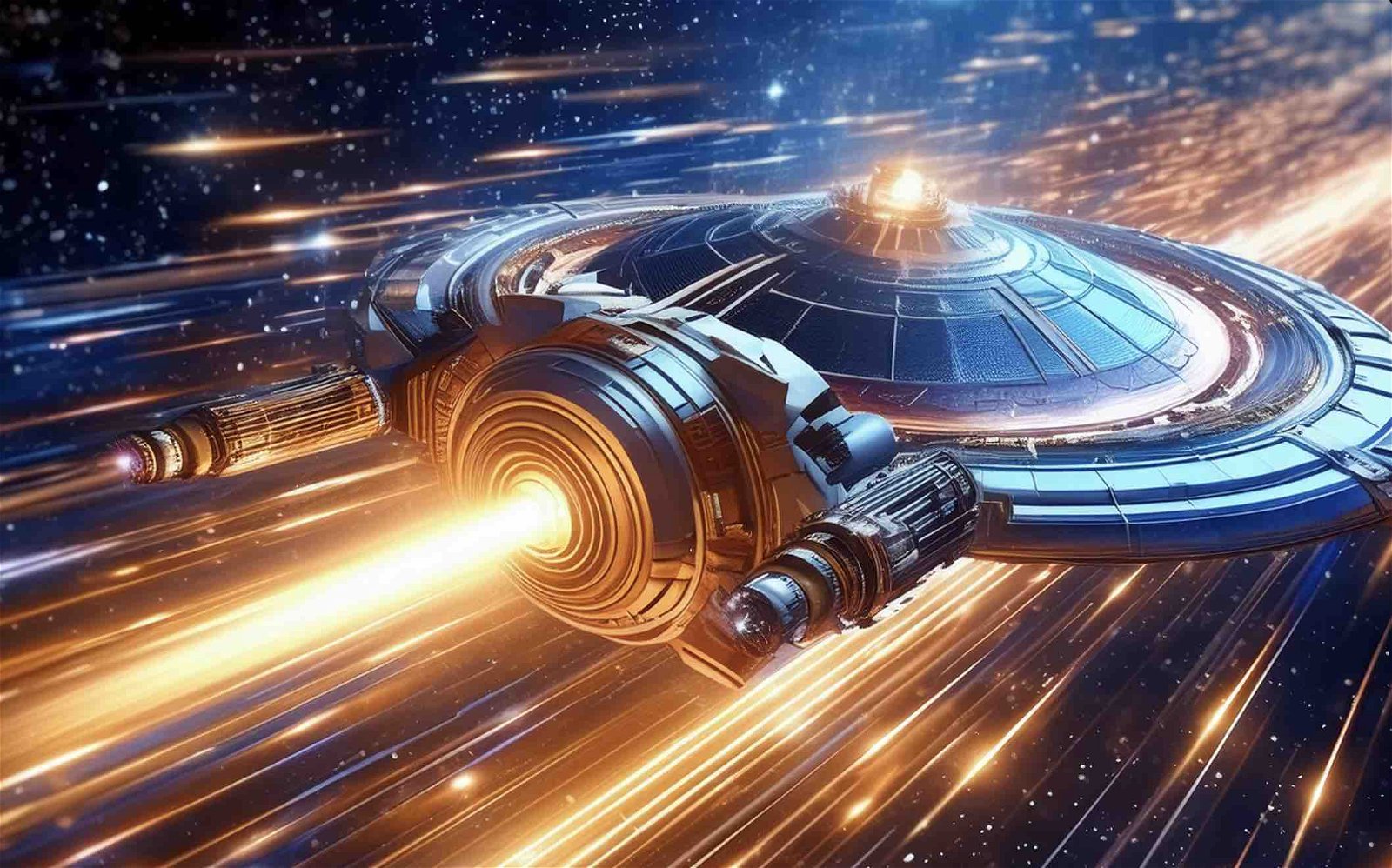An international team of physicists behind several revolutionary warp drive concepts, including the first to require no exotic matter, says that recent unprecedented breakthroughs in physics and propulsion have launched the world powers into a Cold War-style, 21st-century space race to build the world’s first working warp drive.
“We have a space race brewing,” said Gianni Martie, the founder of the Applied Physics (AP) think tank and co-author on a pair of forthcoming warp drive research papers, in an email to The Debrief. “There’s still a ton to discover and invent, but we have the next steps now, which we didn’t have before.”
Comprised of over 30 physicists and scientists in related disciplines, the AP team has gained a sizeable reputation in the warp theory community due to their highly regarded, peer-reviewed papers on numerous warp drive concepts. One of those concepts recently reported by The Debrief has gained significant attention, inspiring many researchers and scientists to declare the team’s “constant velocity warp drive model” as the first practical, viable warp drive concept ever proposed.
The AP team has also created the Warp Factory, a set of development and simulation tools that allow fellow researchers in this nascent field to evaluate the physics of their own models, which can greatly improve the model’s quality and viability.
In an effort to better understand the history of warp theory, the scientific viability of the most current warp drive concepts, what the media always gets wrong about this category of research, and what the next steps in this potential space race might look like, The Debrief reached out to the team at Applied Physics, resulting in an exchange that suggests the futuristic science familiar to viewers of Star Trek may be closer than we think.
THE DEBRIEF: Will humans ever build a working warp drive?
APPLIED PHYSICS: The laws of physics definitely allow for functional subluminal warp drives but not superluminal warp drives. While our constant velocity warp solution is a promising step, many engineering and material science challenges lie ahead, making the timeline uncertain but ultimately dependent on humanity, not physics.
TD: Warp drive research recently celebrated 30 years since Mexican theoretical physicist Miguel Alcubierre proposed the original metric. Has significant progress been made since that first design?
AP: Yes, significant progress has been made. Early ’90s models required non-existent exotic matter, which essentially shelved the science. Work in the ’90s and 2000s reduced the amount of exotic matter needed, but the models were relatively unchanged and thus always remained unphysical. It was only as recently as 2021 that new classes of warp drives came to light, culminating in the first physical warp solution, meaning it doesn’t use exotic matter.
TD: Will material advances be required along the way, or do the basic materials to advance to a working warp drive already exist?
AP: Yes, advances in material science are needed. We require more than just plastic and aluminum to build a warp drive. We’re talking about fluid-like materials at ultra-high densities. The good news is that our physical solution doesn’t require exotic matter, meaning it could be made with particles that already exist in our universe. However, achieving these extreme densities will require new advances.
TD: You’ve said before that the warp research community is currently very small. Have you seen any trends in the literature that indicate this is changing?
AP: Yes, interest has spiked over the last few years. More researchers are spending time on warp field mechanics, indicating a positive trend in the community’s growth. More papers are being written about the subject. Most importantly, warp drives are again considered serious science.
TD: After your well-received study on a viable warp drive dropped this year, did you hear from any researchers who expressed a new interest in exploring this work?
AP: Yes, many researchers from all over the world have reached out, showing interest in helping develop our Warp Factory code and supporting warp drive research. We received hundreds of Warp Grant submissions, and we are narrowing down candidates as we speak.
TD: What is Warp Factory, and how can it help researchers in this field?
AP: Warp Factory is an open-source numerical relativity tool for designing new warp drive spacetimes. Most of the warp drive research so far has been done analytically, which often limits exploration and can take months to analyze even simple solutions. Using Warp Factory, this analysis can be done within minutes while also providing 2D and 3D visualizations. In fact, using Warp Factory was vital to our discovery of the physical warp solution, as it was achieved using a mostly numerical approach. By providing this tool, we envision that creative warp research will be driven by the community in the future.
TD: With Warp-capable vehicles potentially acting as powerful deterrents in global conflicts, how do you foresee warp technology reshaping defense strategies and geopolitical dynamics?
AP: Since it’s so early, there is still much we don’t understand about warp drives to grasp their geopolitical impact fully. Could they have military applications? Possibly, yes, but until we can construct them, it’s unknown. At this stage, we should focus on further developing our understanding of what is possible in the field of warp mechanics. There is a lot of research to be done now that the field is physical, so that’s definitely the first step. If we one day achieve “micro warp” propulsion in a lab, it would certainly trigger serious defense spending, as no nation can ignore a new means of propulsion. However, we hope the research stays civil. It would be quite shameful to achieve such technical prowess only to throw rocks at warp speed when the technology can be used to stimulate GDP and explore new frontiers.
TD: How will a “Warp Drive Space Race” affect education in the U.S.?
AP: Just like with the last space race, we are expected to see a huge surge in STEM (Science, Technology, Engineering, and Mathematics) jobs. This is already happening today, as we see nations like China and India setting space records, making it clear that the U.S. has competition. And competition is good; we need the drive, the excuse to get up in the morning. Both American and Russian economies benefited greatly from the first space race. The demand for skilled professionals in fields such as advanced engineering, condensed matter physics, and warp field mechanics is set to skyrocket, creating millions of new high-quality STEM jobs. This technological renaissance fosters innovation, drives economic growth, and positions these nations at the forefront of the next great leap in human civilization.
TD: What is Applied Physics doing next in their warp research?
AP: Applied Physics is continuing to explore new types of warp drives, which we hope to share soon with the community. We are currently researching the unique ways that warp drives accelerate and evolve over time compared to traditional propulsion methods.
TD: Have we entered the Warp Age? If so, has a Warp Drive Space race already begun?
AP: Humanity has made small steps into the warp age from a theoretical perspective, and recent efforts show that we can make advances in the field. In terms of a new space race, not yet, but interest is growing. China published warp papers soon after our paper came out, and they have been heavily investing in space.
TD: In the 20th-century Cold War space race, many credit the USSR’s launch of Sputnik in 1957 as the seminal event that set things in motion. What could the Sputnik moment in the warp drive space race look like?
AP: The “Sputnik moment” for warp drives would be the first successful demonstration of warp movement, sparking investment and interest similar to the original space race. This will likely be a miniature “micro warp” laboratory prototype.
TD: If the U.S. government authorized a Manhattan Project-style budget for warp drive research, what might the first steps of that effort look like?
AP: It’s only a matter of time before warp drives become part of defense spending, as the science has been proven. Initial steps would include setting up a state-of-the-art research facility, attracting top scientists, and focusing on solving key theoretical and engineering challenges. Since warp field mechanics represents a new physical science, there is a lot of low-hanging fruit with plenty to discover, as the floodgate is freshly open. This would be the second official government funding of warp drive technology, as Eagleworks Laboratories was established by NASA in 2012.
TD: Last, what, if any, final message would you like to convey to those hoping to see a working warp drive become a reality?
AP: The dawn of the Warp Age marks a pivotal moment in human history, presenting both unparalleled opportunities and significant challenges. As we navigate this new frontier, the balance between innovation and responsibility will be crucial in shaping a future that harnesses the benefits of warp technology while ensuring a stable and peaceful world.
Christopher Plain is a Science Fiction and Fantasy novelist and Head Science Writer at The Debrief. Follow and connect with him on X, learn about his books at plainfiction.com, or email him directly at christopher@thedebrief.org.

